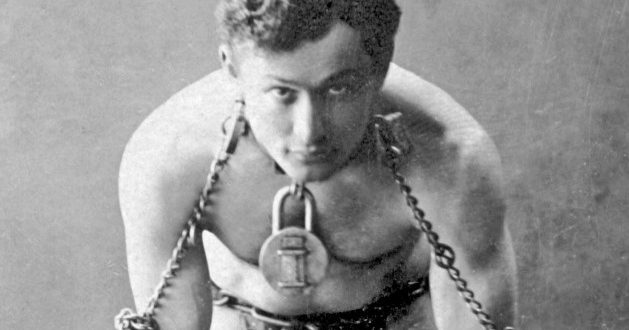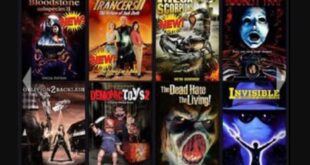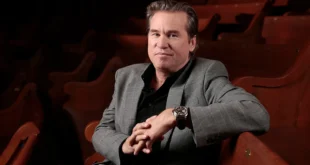Having a love of horror, I have always asked, “Could any of this ever be real?” Every so often, the worlds of fiction and nonfiction cross and make things blurry. Take, for instance, the esteemed Harry Houdini.
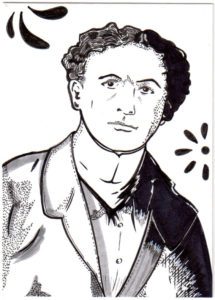
October 31, 2021, marks 95 years since Houdini escaped from his physical form and into the “Great Unknown.” Recently, I wrote an article about my adopted hometown of Williamsport, Pennsylvania for a local news site called On the PULSE. Knowing my interest in Houdini, the Grand Poo-Bahs of PopHorror, asked me to write a piece on him, so let me begin where I left off – in Williamsport, Pennsylvania in 1924.

Houdini’s Disbelief in Spiritualism
On October 9, 1924, Houdini stopped at the Pine Street United Methodist Church as part of his lecture series titled Fraudulent Spiritualistic Phenomena.
Some years before, Houdini—who was devoted to his mother—had received a communication from an entity that claimed to be his mother. The medium that was part of the communication was Jean Doyle, wife of Arthur Conan Doyle, the creator of Sherlock Holmes (the irony has never been lost on me) and Houdini’s former friend.
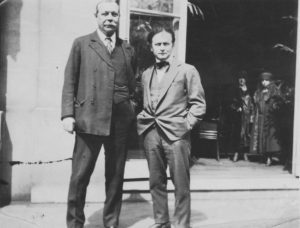
“Sir Arthur Conan Doyle, creator of Sherlock Holmes, but of (recent) years a writer on spiritualism, and his wife (Jean), an automatic writer, who claimed to have written a 23-page letter from (my) mother,” Houdini said in an article from The Tennessean published on March 12, 1924. The story chronicled Houdini’s visit to Nashville’s Ryman Auditorium on the same aforementioned lecture tour. “(The message supposedly from Houdini’s mother) was couched in the purest English,” Houdini said. “And yet my mother could neither write nor speak English, being educated on the European continent.” This pushed him into a battle with the spiritualists, mediums, and psychics. As reported to the Oct. 19, 1924 edition of the Williamsport Gazette Bulletin, Houdini said that in all his extended travels, he has not found one genuine medium.
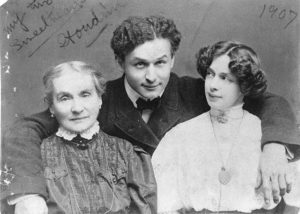
To understand a little bit about what spiritualism was exactly, I had reached out to my old friend, Robert Damon Schneck, known as America’s Historian of the Strange. According to him, spiritualism is the belief that psychics and mediums communicate not only with God, but with spirits and angels and other beings, not just with prayer, but with spirit boards, automatic writing and possession by otherworldly beings.
I asked him about how readings and seances were fixed. “It was not very sophisticated,” Schneck said. “Sometimes, the mediums would have assistants in costumes pretending to be ghosts. Also, they would use foldable rulers that would be extended and would tap the victims on the thigh or shoulder. Remember, you have a bunch of people excited and full of expectation waiting for something to happen, so it did not take much.”

Houdini said the exact same thing. “Grief and the will to believe are the major causes why the visitors at seances are impressed by the spurious activities of the mediums.”
As for the fakes, the artist said that thanks to decades of performing on stage and movies, it has given him a unique experience. “My business has given me an intimate knowledge of stage illusions, together with many years of experience among show people of all types. My familiarity with the former, and what I have learned of the psychology of the latter, has placed me at a certain advantage in uncovering the natural explanation of feats that to the ignorant have seemed supernatural,” Houdini explained in his book, Miracle Mongers and Their Methods.
Houdini Honored In Williamsport, Pennsylvania
“Houdini’s campaign against spiritualism fits in with his character,” says Dorothy Dietrich, co-owner of the Houdini Museum in Scranton, Pennsylvania with Dick Brookz. In 2016, Dietrich and Brookz took part in having a sign placed in Williamsport honoring Houdini.
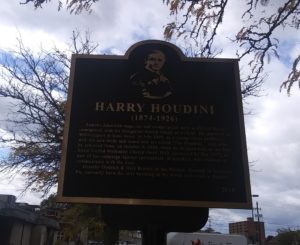
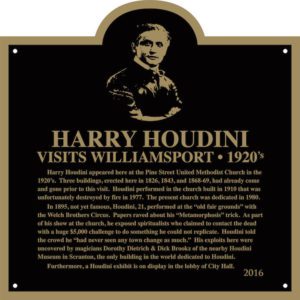
“He would also travel the world and visit the gravesites of famous performers, and if they were in need of repair, he would handle it,” Dietrich said in a telephone conversation. “In fact, he would regularly give money to performers and magicians who were in need.”
She also said Houdini was also a patriot. “Houdini loved America, and he signed up for the military, but they did not accept him. So, he took the time off from his normal shows and did shows and benefits for the American Red Cross,” Dietrich said. “He really cared.”
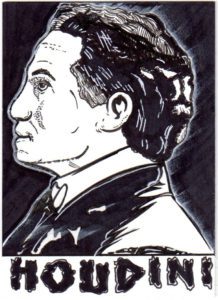
“Death Within Year In Protest Against Magician’s Exposures”
However, after years of lectures and performances, he was met with resistance, and it was not pretty. I came across this article from The News-Journal of Lancaster, Pennsylvania dated December 23, 1924, reporting that spirits prophesied that Houdini would face death within the year after exposing the fraud. The paper stated that his upcoming death would be “Harry Houdini’s punishment for impugning the validity and honesty of Mrs. Le Hroi G. Crandon, the Boston doctor’s wife who gives psychic seances under the ‘spirit’ name of Margery,” and that the “dire threat has been carried from Margery to Houdini by semi public statements made in the name of the evil spirits.”
Houdini seemed to take it in stride, although what he described next is actually scary. “A doll image of me will be made. The doll will stand at the bedside of my enemy who will pierce it with pen knife blades while chanting certain… curses characteristic of the black image of the middle ages.” He was of the opinion that “belief in black magic is an absurd survival from the dark century during which alchemy, astrology, demonology, and Rosicrucianism combined to addle the wits of misguided men…. That men and women of today are still meddling with the rituals of that anti-Christ and burning malodorous powder as in darkened cellars to be spirit of Beelzebub seems an absurdity, but it is true… When the human intellect is caught between charlatanism and ignorance the result is both preposterous and malignant.”
Yet, within two years of this article being printed, Houdini would be dead at age 52.
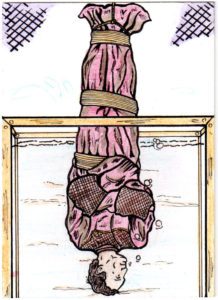
Houdini was in Detroit for a show when he was taken to Grace Hospital for an operation for acute appendicitis. Houdini had appeared at another local theatre the previous night despite being in considerable pain and having a temperature of 104, which was reported in The New Castle (PA) News on October 25, 1926. Apparently, Houdini collapsed during a recent performance and went on with this show against his physician’s advice, so as not to disappoint the crowd.
The next day, The Shamokin (PA) News-Dispatch reported that Houdini “still was in a serious condition” for acute appendicitis. “Attending physicians announced that his recovery was doubtful. They explained that the appendix had ruptured far over on the left side of the abdomen and… peritonitis had developed,” the article said.
The news got worse and worse.
On October 31, 1926, at 1:26 p.m.—though his death certificate said 1:30—Houdini, “the magician whose feats of… seemingly miraculous escapes thrilled audiences throughout the world, and whose exposure of spurious mediums won him the commendation of scientists, succumbed today to peritonitis, unable at the last to escape the call of death,” said the Pittsburgh Daily Post on November 1, 1926.
Now let me say this: anyone with any interest in Houdini or his life knows about the controversy and the speculation of the knucklehead who punched him in the stomach and caused Harry’s appendix to rupture. There are a ton of conspiracies about his death. Some people believe that said the person was put up by the mediums to do Houdini in.
Much the same way as President John F. Kennedy, Lizzie Borden, Jack the Ripper, Amelia Earhardt and the like, writers, creators, investigators, and enthusiasts will continue to debate what really occurred.
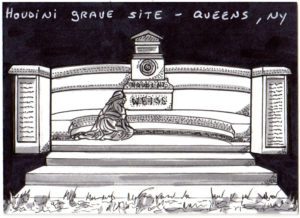
Houdini’s Final Resting Place
Houdini’s remains are interred in the Machpelah Cemetery in Queens, New York. An elaborate grave marker with a bust of his head was constructed. However in 1983, another knucklehead decided to desecrate it. According to a Newsday article published on August 15, 1983, a “thief who hacked the magician’s bust off from atop his Queens grave mysteriously escaped with it sometime during the weekend.” It would remain that way for almost four decades. Remember earlier that Dorothy Dietrich said Houdini would regularly repair the graves of forgotten magicians? This time, she stepped up.
At the Houdini.org website, is a great picture of Dietrich with her partner, Brookz, standing in front of a newly reconstructed bust of Houdini’s head.
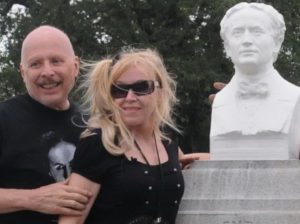
“We restored Houdini’s bust to his grave site, missing for 36 years,” Dietrich said. As they were working, a hawk flew down to watch them. Oddly enough, Houdini’s last show featured his pet hawk.
As I bring this essay to a close, I can’t help but think that dying at 52 is a case of gone to soon. However, Houdini still inspires people today. I’d like to quote John Cox, writer and owner of the website, Wild About Houdini. He said that while October 31, 1926 is the anniversary of Houdini’s death, it also marks the “start of Houdini’s amazing afterlife, in which he not only continued to be the most famous name in magic, but grew to become one of the most famous individuals of the entire 20th century.”
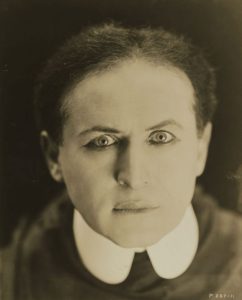
Abra-kadabra!
***
NOTE: Thank you to Dorothy Dietrich of Houdini.org, John Cox of WildAboutHoudini.com, Robert Damon Schneck, of Historian of the Strange and artist Rusty Gilligan for their assistance in creating this article.
 PopHorror Let's Get Scared
PopHorror Let's Get Scared
